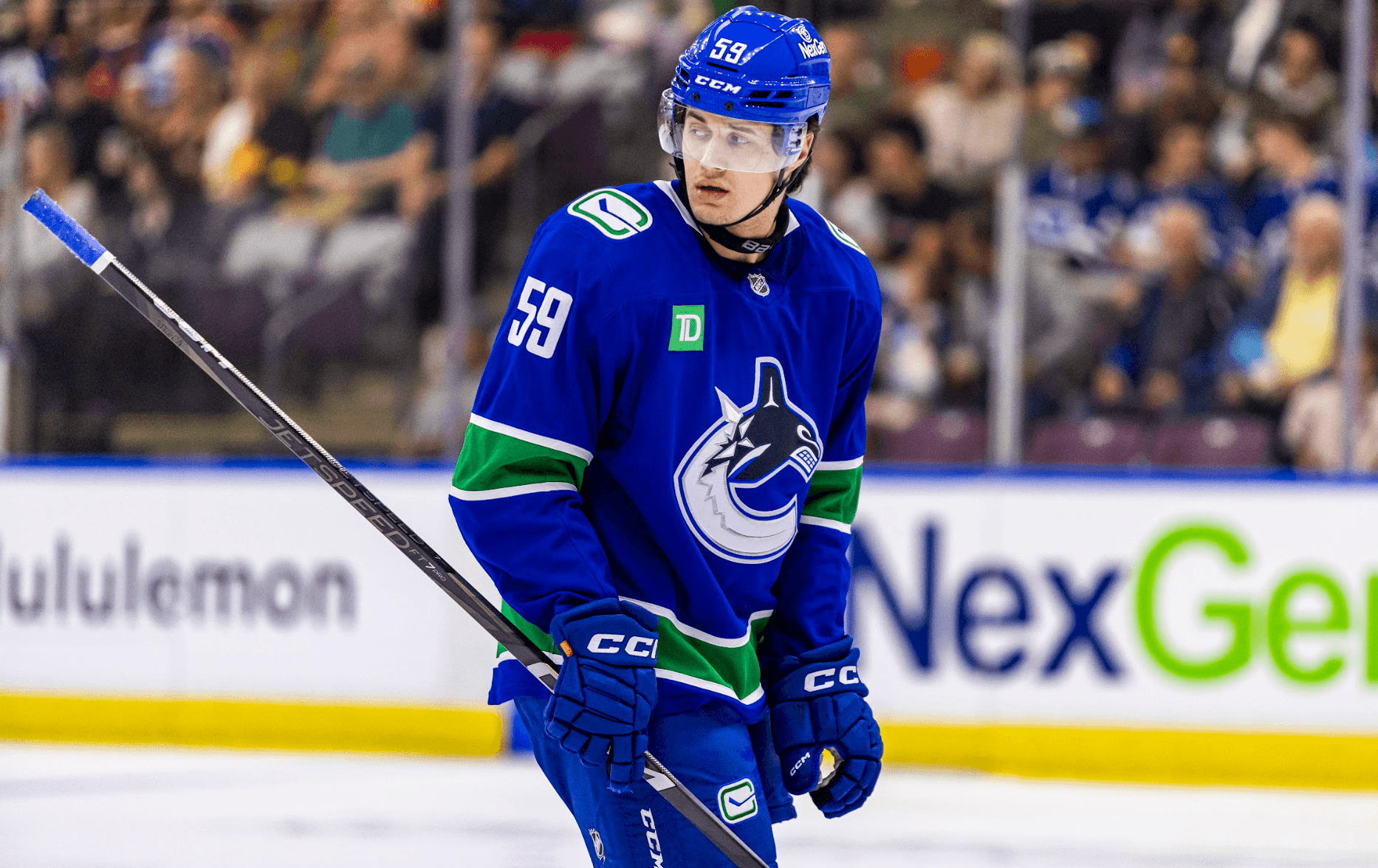Nation Sites
The Nation Network
CanucksArmy has no direct affiliation to the Vancouver Canucks, Canucks Sports & Entertainment, NHL, or NHLPA
Daniel Gee: Breaking down Kirill Kudryavtsev’s translation to Professional Hockey

Photo credit: © Tav Morisson-CanucksArmy
By Daniel Gee
Mar 28, 2025, 16:00 EDTUpdated: Mar 28, 2025, 14:22 EDT
When you look back at the 2022 NHL Entry Draft, it’s easy to see the early returns for the Vancouver Canucks.
Jonathan Lekkerimäki has grown leaps and bounds to become a more engaged and dangerous goal scorer who is flashing a separating ability to score while blending deception with the puck. Elias Pettersson, the left-side defender, is already an AHL allstar pick, seamlessly translating a mobile but bruising game to Canucks. Even goaltending prospect and former fifth-round pick, Ty Young, is finding success tending goal for the organization’s farm teams.
Still, there is another prospect to note from that draft class.
Enter, Kirill Kudryavtsev.
Selected with the 208th selection in the seventh round, Kudryavtsev arrived this season on the back of a stingy, yet creation-focused, Canadian Hockey League career with the Soo Greyhounds – one where he was even voted as the most underrated player of his conference, an honour bestowed in the annual OHL coaches poll.
Now a professional player with the Abbotsford Canucks, Kudryavtsev is nearing the conclusion of an overly successful rookie campaign. A hybrid, left-shot defender who plays both sides of the ice, the Russian product has been adaptable, thrust into high-leverage minutes, blending deft reads and overwhelming disruption.
Second in defenceman scoring with his AHL club, Kudryavtsev’s two-way game and instant translation isn’t the biggest surprise to people who have watched him in the past. That being said, the speed at which it has happened is.
Defending as an AHL Rookie and Kudryavtsev’s adaptation
Often, when defenders take the step from the CHL to the professional game, the process is fraught with new challenges. These aren’t teenagers or early 20-year-old players that you are contending with. For the most part, this is a league of grown men vying for NHL spots – there is even more at stake. The pace at which the game is played is higher, opponents are physically stronger and more detailed, and every advantage possible will be exploited.
While you can project a prospect’s ability to read and disrupt plays to higher levels of hockey by looking at their habits and tools, you never really know how fast that will come. For Kudryavtsev, it’s been instant.
He is essentially Young-hee, a motion-detecting animatronic from Netflix’s Squid Game. Kudryavtsev catches any movement with constant shoulder checks and head swivels, taking that information and building a mental map of the ice. Out of that, his reads this season have been beyond impressive.
An activator streaking through the middle of the ice? Kudryavtsev is already there, checking the release. A cross-zone pass, east-to-west? It’s not surprising to see a deflection off his blade. A backdoor, secondary threat, timing their entry into a pass lane? The former seventh-round pick is usually there to push them off balance.
Throughout Kudryavtsev’s tape this season, proactiveness and details drove his disruptive, play-stopping game.
He targeted sticks, jumped into passing and shooting lanes, even darting out to challenge opponents in open ice, limiting time and space.
Physically, he’s a bulldog around the net and on the perimeter of the ice. While he is a sub-six-foot defender, Kudryavtsev is no lightweight, listed at 200 pounds. He uses his build to create leverage, primarily through his low centre of gravity, getting under opponents to shove them off pucks and mess with their balance. He darts to find inside positioning, widening his base and freeing his stick to make plays in small-area battles and release pressure.
His end-board pins result in trapped feet, leading to board seals, even if he struggles to contain his opponents completely. Kudryavtsev also flashed some ability to combat more slippery opponents, ones who employ cutbacks and punch turns to shake off pressure — a common sight in the NHL game. Quick footwork to match these attackers step-by-step is essential.
Then you get into defending off the rush. In contrast to other left-shot prospects across the Canucks system, Kudryavtsev isn’t the most physically aggressive defender. His play-stopping is centred around his defensive skating and stick work. Switching between an overextended reach and a hidden, pulled-back timed pokecheck, he finds moments to slow up threats, keeping a consistent, steady-footed gap, and other moments to swing on pucks, surprising puck carriers. His timing is higher-end, and he often waits to engage upon the pass reception.
Against trickier attackers who adjust their rush pattern and attack through dynamic lanes, Kudryavtsev simply crosses over to stay in front of the attackers. Part of his effectiveness comes down to his judgment of speed. Deft pivots to create separation, allowing him to get in position and face the puck carrier, are a common sight. He’s not a burner operating through high-activity rate skating and edge work.
Handling Professional-level forecheck
Kudryavtsev is one of the slicker puck retrievers that I have scouted. On rare occasions, he’s sent foreckers flying into the boards by changing the direction of his feet, ultimately manipulating them. On other occasions, Kudryavtsev again leverages scanning to find clearer ringouts and passing lanes. He’s relatively unfazed by physicality, working through it, hoping to find a supporter — shielding is key.
Out of retrievals, he’s relatively simple on the breakout. One and two-line stretch passes, board banks, and the occasional carryout with control are all part of his mix. Nevertheless, Kudryavtsev tends to defer. This is an area of his game that will likely evolve. Breaking out passes in motion will be a key habit going forward, as he did have some static, easy-to-pick-off attempts throughout his tape.
How he continues to generate scoring chances
Kudryavtsev was an analytical darling during his time in the OHL. Elite Prospects’ Mitchell Brown tracked his five-on-five game. He was a 99th-percentile generator of expected goals, a 96th-percentile volume shot taker, and a significant generator of board-to-middle plays.
The good news is that these habits have extended to the professional game. Almost all of Kudryavtsev’s shooting efforts originate in the middle of the ice, mostly off concerted lateral movement off the side boards. He cuts inside, holds pucks at his hip to fend off pressure, and tactically places shots low to create rebounds, redirections, and general chaos.
He flashed some ability to use feints off the blueline to freeze the high-pressure pusher and open pass lanes. In addition, Kudryavtsev blends occasional activation, dropping off his point and working downhill as a weakside target.
With this collection of habits, it wouldn’t be out of the question to expect Kudryavtsev to break out even more offensively in the coming years. It will take opportunity and further leveraging of his deception and shot quality, but the ability is there.
Future and why penciling in players on an NHL roster is fun but fruitless
Penciling prospects into future lineups has always been a fun exercise. It’s armchair GM work — a cornerstone for any obsessed fan. For Kudryavtsev, you could look at his advanced level of play as a rookie, the collection of tools/habits, and project him out as an NHL defender — one that could insulate and generate offence off a bottom pair.
It’s also easy to look at Vancouver’s depth chart and see limited room for the former Greyhound, a path that may mean he’s used as an asset in a trade down the road.
However, this isn’t a realistic exercise simply because of the dynamic nature of NHL roster turnover. Players come and go, some expected and some not. Prospects may excel in one season and find regression in the next. There are so many factors that create opportunity. Vancouver has used 13 defenders this season alone, and the lack of practice time and travel has ravaged the organization in many seasons.
The point is that it’s hard to know what will happen. What we do know is that Kudryavtsev’s projection to the NHL was already strong based on his OHL play, and this rookie AHL season, so far, only strengthens that bet.
Sponsored by bet365
Breaking News
- 3 Canucks Stars of the Week: Quinn Hughes’ last dance
- The Farmies: Victor Mancini goes coast-to-coast, but Abbotsford Canucks fall short in overtime
- The Statsies: Buium and Rossi make strong statements in Canucks win against Devils
- JPat’s Monday Mailbag: Should fans believe Canucks ownership will commit to a rebuild this time?
- How the Canucks’ return in the Quinn Hughes trade compares to past NHL blockbusters
